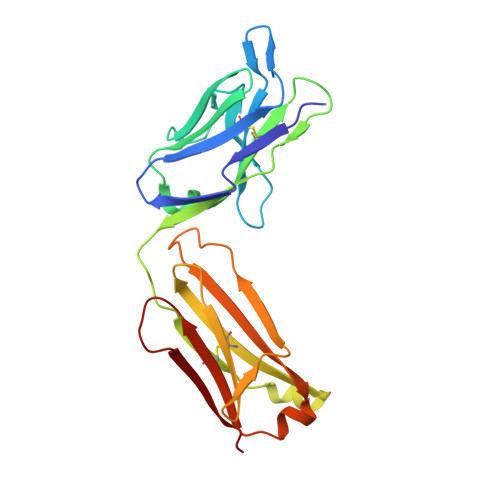Structural basis for the interaction of human herpesvirus 6B tetrameric glycoprotein complex with the cellular receptor, human CD134.
Nishimura, M., Novita, B.D., Kato, T., Handayani Tjan, L., Wang, B., Wakata, A., Lystia Poetranto, A., Kawabata, A., Tang, H., Aoshi, T., Mori, Y.(2020) PLoS Pathog 16: e1008648-e1008648
- PubMed: 32678833
- DOI: https://doi.org/10.1371/journal.ppat.1008648
- Primary Citation of Related Structures:
6LKT, 6LTG - PubMed Abstract:
A unique glycoprotein is expressed on the virus envelope of human herpesvirus 6B (HHV-6B): the complex gH/gL/gQ1/gQ2 (hereafter referred to as the HHV-6B tetramer). This tetramer recognizes a host receptor expressed on activated T cells: human CD134 (hCD134). This interaction is essential for HHV-6B entry into the susceptible cells and is a determinant for HHV-6B cell tropism. The structural mechanisms underlying this unique interaction were unknown. Herein we solved the interactions between the HHV-6B tetramer and the receptor by using their neutralizing antibodies in molecular and structural analyses. A surface plasmon resonance analysis revealed fast dissociation/association between the tetramer and hCD134, although the affinity was high (KD = 18 nM) and comparable to those for the neutralizing antibodies (anti-gQ1: 17 nM, anti-gH: 2.7 nM). A competition assay demonstrated that the anti-gQ1 antibody competed with hCD134 in the HHV-6B tetramer binding whereas the anti-gH antibody did not, indicating the direct interaction of gQ1 and hCD134. A single-particle analysis by negative-staining electron microscopy revealed the tetramer's elongated shape with a gH/gL part and extra density corresponding to gQ1/gQ2. The anti-gQ1 antibody bound to the tip of the extra density, and anti-gH antibody bound to the putative gH/gL part. These results highlight the interaction of gQ1/gQ2 in the HHV-6B tetramer with hCD134, and they demonstrate common features among viral ligands of the betaherpesvirus subfamily from a macroscopic viewpoint.
Organizational Affiliation:
Division of Clinical Virology, Center for Infectious Diseases, Kobe University Graduate School of Medicine, Kobe, Hyogo, Japan.
















